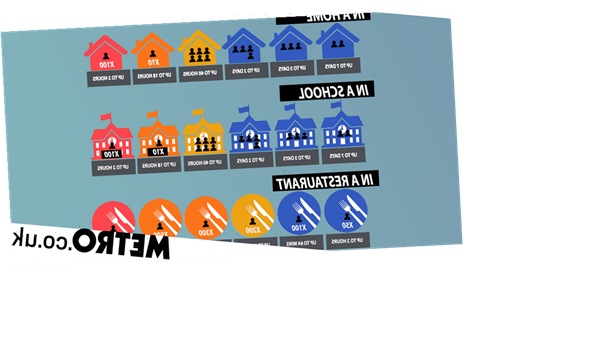A new tool has been created to show people how likely it is they will catch coronavirus if someone in their home, office or school is infected.
Anyone can use the tool, designed by the Massachusetts Institute of Technology, which found human behaviour has the biggest impact on the likeliness of the virus spreading.
People wearing high-quality face masks properly has the most effect on changing the amount of time people can spend in a room together safely.
You can try the interactive tool at the website here.
Visit our live blog for the latest updates Coronavirus news live
In a naturally ventilated classroom with 19 students, one teacher and no one wearing masks researchers estimated it would take 2.3 hours before the first coronavirus transmission took place.
In a mechanically ventilated classroom it would take 18 hours and with both ‘enhanced ventilation’ and ‘judicious mask use, this time limit could be extended to several weeks, and so exceed the recovery time for Covid-19’.
People can change the size of the room on the tool, filter what ventilation the room has, what masks are being worn, how strict people in the room are about wearing their masks correctly and even how loud people are being.
But the technology can only calculate the risk for one infected person in the room, not several.
The tool will then tell people how safe it is to stay in a place before they risk being infected with coronavirus.
Users can also mock up festive season scenarios in their homes and see what situation would pose the most danger.
In a standard room – with 8ft ceilings, 15ft walls and closed windows – 10 young people carefully wearing surgical face masks could chat safely in the room for two hours.
But for a family of 10 with some elderly members in the same type of room, with no one wearing masks while eating, the time limit is dramatically cut to just three minutes.
In a 400 square ft living room, five young people wearing a N95 respirator can dance and sing for 35 minutes.
Simply dropping their masks below their chin takes the safe time all the way down to four minutes.
However the data about classrooms and homes is not replicated in care homes where their findings ‘sound the alarm’, said the researchers.
Three elderly people in a room with the windows open, with 80 square ft of space each, following the two-metre rule can still only be there safely for three minutes.
Researchers said: ‘This example provides insight into the devastating toll of the Covid-19 pandemic on the elderly.
‘Furthermore, it underscores the need to minimise the sharing of indoor space, maintain adequate, once-through ventilation, and encourage the use of face masks.’
The calculations used to create these results were published on the pre-print server medRxiv.
App developers said they think it provides more nuanced guidance than current guidelines on bubbles and socially distancing.
Get in touch with our news team by emailing us at [email protected].
For more stories like this, check our news page.
Source: Read Full Article


